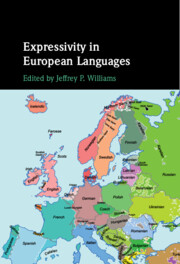Book contents
- Expressivity in European Languages
- Expressivity in European Languages
- Copyright page
- Contents
- Figures
- Tables
- Contributors
- 1 Introduction
- Uralic
- Germanic
- 4 Expressivity in Scots: A study of echo words
- 5 Reduplication as expressive morphology in German
- Hellenic
- Romance
- Celtic
- Vasconian
- Caucasian
- Comparative
- Index
- References
4 - Expressivity in Scots: A study of echo words
from Germanic
Published online by Cambridge University Press: 24 August 2023
- Expressivity in European Languages
- Expressivity in European Languages
- Copyright page
- Contents
- Figures
- Tables
- Contributors
- 1 Introduction
- Uralic
- Germanic
- 4 Expressivity in Scots: A study of echo words
- 5 Reduplication as expressive morphology in German
- Hellenic
- Romance
- Celtic
- Vasconian
- Caucasian
- Comparative
- Index
- References
Summary
Scots, like too many other European languages, is viewed as possessing a dearth of expressivity in spite of evidence to the contrary. This chapter documents the fact that Scots possesses a wide range of forms of expressivity as part of its grammatical repertoire – including most notably echo word formations. Echo words are a type of apophonic reduplication where a root, stem, or other morphosyntactic constituent is partially reduplicated and there is a concomitant change in the echoant; the reduplicated, or copied, portion has no independent semantic value. The change in the copy portion can involve vowel ablaut, consonant alternation/substitution, or tone/register changes.
Keywords
- Type
- Chapter
- Information
- Expressivity in European Languages , pp. 91 - 102Publisher: Cambridge University PressPrint publication year: 2023



